Last Updated on June 13, 2022
Brakes are one of the most important components of any vehicle. Keeping your brake system in good condition is one of the best ways to ensure that a vehicle has a long lifespan and keeps you safe at the same time.
When the braking system fails, there can be a variety of possible causes for failure. A common cause of brakes malfunctioning is often attributed to a brake fluid leak.
Because a typical car brake system is made up of four areas (brake master cylinder, brake lines, front brake calipers, rear brake calipers or drums), the location of the leak will be found in one of those locations. Most often the fluid leak can be found at a caliper so you’ll want to start there.
How do you know when you have a brake fluid leak? Obviously, a puddle of brake fluid on the ground is a clue but here are some additional signs of leaking brake fluid.
Top 5 Common Brake Fluid Leak Symptoms
#1 – Brake Warning Light On

This will usually be the first sign a driver will notice that corresponds to a problem with your brakes since a warning light turning on in your instrument cluster is easily noticeable.
It may not necessarily mean you’re leaking fluid, but as mentioned above, most brake problems are as a direct result of low brake fluid so consider it an early indicator.
See Also: Check Engine Light (Why It’s On and How to Reset)
#2 – Puddle of Brake Fluid
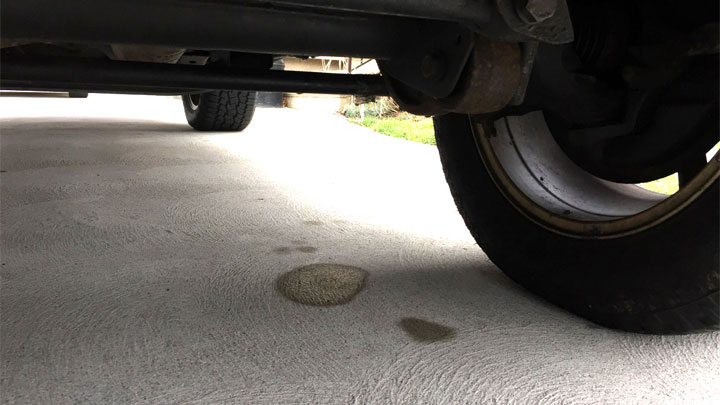
If you notice a small puddle or drips of fluid near the wheels or on the wheels, it’s likely leaking brake fluid. If the brake master cylinder is leaking or the brake lines are, brake fluid will be underneath your car and a bit more difficult to determine whether it’s brake fluid, transmission fluid, or even motor oil.
Brake fluid is light yellow or even clear when new and gradually darkens as it ages. It has a very oily feel (even slicker than oil) and has a rancid smell almost like fish oil. The properties make it fairly easy to confirm that fluid on the ground is in fact brake fluid.
As a final confirmation, check to make sure your brake fluid reservoir is full. If not, you likely have a leak.
#3 – Brake Pedal Feels Squishy
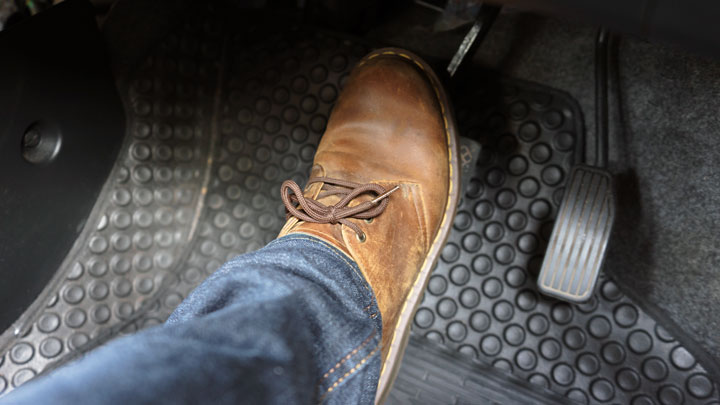
When you push down on the brake pedal to slow down or stop your car, it should feel firm with only a small amount of travel before your brakes are engaged. If instead the brake pedal feels soft, mushy, spongy, or squishy, it’s likely the result of air getting trapped in your brake lines.
Normally, brake lines should be completely full of brake fluid (this is why we “bleed brakes”) to function properly. If there is not enough brake fluid in the system due to a leak, air will enter the brake lines and you could have serious consequences if you need to stop.
#4 – Brake Pedal Goes Down to Floor

This often occurs alongside your brake pedal feeling soft or squishy. When you have a severe brake fluid leak or problem with the brake master cylinder, you will experience what some call “brake pedal sink“. This simply means there is not enough brake fluid in the lines for the brakes to function.
If you notice this happening before you start driving, do not attempt to drive the car as driving a car without functioning brakes is about at serious as it gets.
If you experience this while driving, immediately force your car to slow down by downshifting gears or even slowly applying the emergency brake and safely get off the road. Do not drive the car until the issue is fixed.
#5 – Poor Stopping Performance
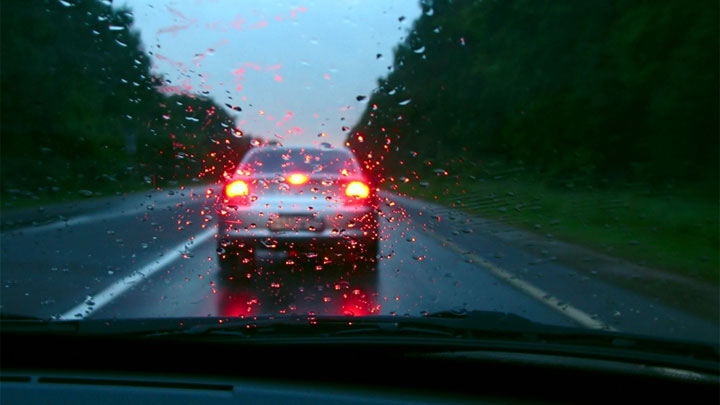
While poor braking performance can be attributed to many issues including issues with brake pads, rotors, calipers, and more, it can also be because of your brake fluid leaking.
Most people will notice one of the above symptoms first but if you feel like something just doesn’t seem right with the way your car brakes, check your brake fluid reservoir at the earliest opportunity. If the reservoir is not full, you likely have a leak somewhere.
No matter which symptom above you experience, you should not continue driving your vehicle until you get it checked out and fixed. Non-functioning brakes are one of the most serious car problems that can occur and are literally life-threatening.
While it’s definitely possible to diagnose and fix a brake fluid leak yourself, this is one of those times you want to contact a mechanic unless you’re 100% sure you know what you’re doing.
Related: Symptoms of a Bad Brake Booster
Average Brake Fluid Leak Repair Cost
On average, depending on the make and model of car being serviced, the cost of fixing a brake fluid leak isn’t too severe. This is not a repair that is going to set a vehicle owner back very much money when compared to some of the more costly types of automotive repair procedures.
With the average make and model, you can expect the cost of repairing a brake fluid leak to be:
| Type of Leak | Repair Cost |
|---|---|
| Brake Master Cylinder Leak | |
| Repair | Parts = $100-$200 Labor = $80-$140 |
| Replace | Parts = $200-$300 Labor = $40-$80 |
| Brake Line Leak | |
| Repair | $100-$200 |
| Brake Caliper Leak | |
| Repair (one side) | Parts = $100-$200 Labor = $80-$100 |
| Replace (one side) | Parts = $200-$300 Labor = $40-$80 |
| Rear Drum Cylinder Leak | |
| Repair | Parts = $10-$20 Labor = $80-$100 |
| Replace | Parts = $25-$40 Labor = $40-$80 |
However, it is possible to fix the issue by yourself as long has you have sufficient automotive experience and know what you are doing.
For everyone else, hiring a mechanic is going to be the smartest course of action to take to ensure that any and all braking repairs are performed carefully and correctly the first time.
When repairing a leaking brake line, there is no real margin for error because if the brakes do not work, then this is putting a driver (and those around him) in a significant amount of risk.
For anyone in need of pricing, the average brake line repair cost is also noted in the table above.
How to Diagnose a Brake Fluid Leak
Brake Master Cylinder Leak
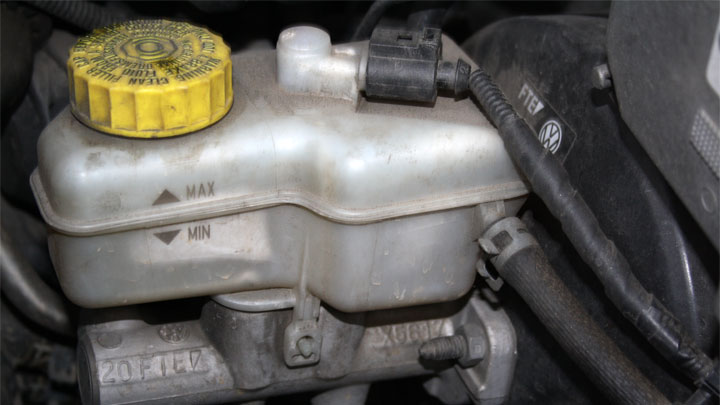
Since this is the easiest to do, a quick visual inspection of the brake master cylinder should be done. Just check the condition on the brake master cylinder area to see if fluid is present on the outside.
Brake Line Leak
Here you’ll need to do a visual inspection under the vehicle chassis to see if there is any brake fluid present on the ground. If there is, then this will confirm the approximate location of a leak.
If there is fluid leaking, it would be wise to then prevent the fluid from getting everywhere by laying some newspaper down on the ground underneath the car. Better yet, garage floor mats exist for this very purpose. They are the the ideal way to contain a brake fluid leak, or any type of fluid leak coming from your car.
To confirm the location of the leak, you’ll want to get in the car and pump the brake pedal to force any remaining brake fluid out. After that, it will be safe to get under the car again to pinpoint the exact leak location. Once the leak is found, the brake line can either be repaired or replaced.
Brake Caliper Leak (or Rear Drum Cylinder)

Inspecting Brake Caliper or Rear Drum Cylinder: In this step, you must open each tire to check the leak at each caliper. If inspecting the rear brake using brake drum, you should open the drum to check the drum cylinder inside the brake drum.

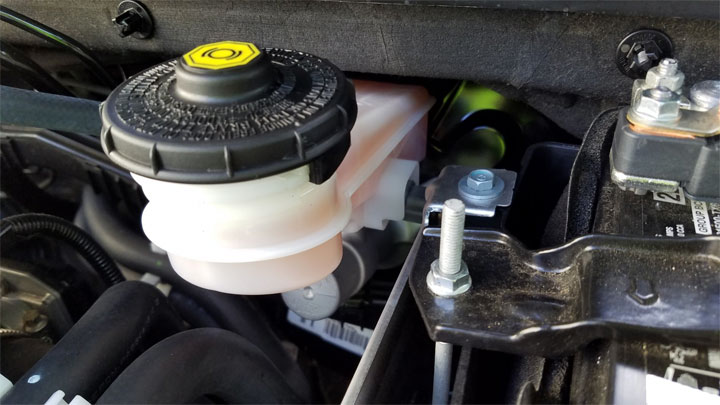
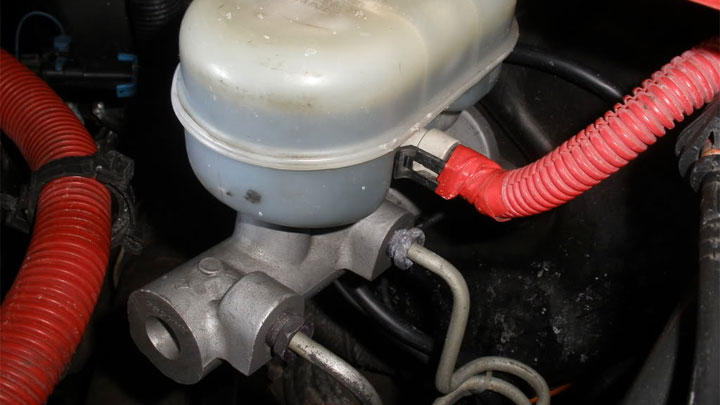
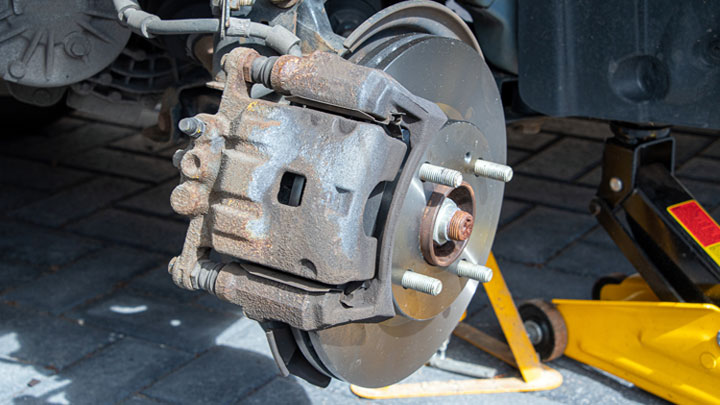
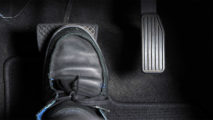
super idea given to me
thanks lot of
brake oil tank leak identify easier
thanks
Thanks, happened to my car where there drips of yellowish fluid on the left hand side front wheel. Thought it was the the transmission O ring leakage. Well, 8 yrs old car getting sick here and there and frequent visits to the mechanics.